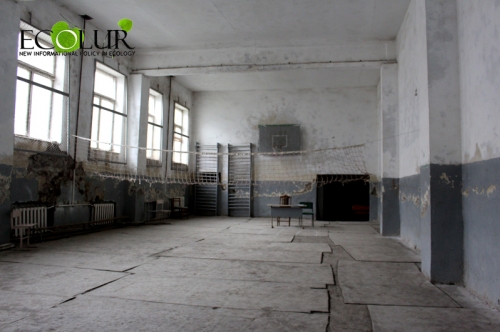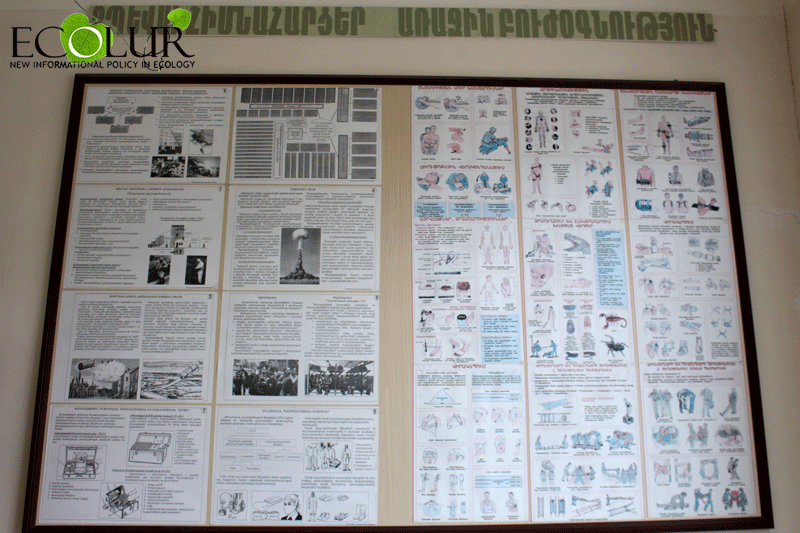

EcoLur
EcoLur continues presenting the series of materials on the residents of impacted residential areas, local active civil society and local government bodies on safety measures related to awareness, preparation in emergencies, and participation in decision-making processes.
We are presenting the results of the monitoring carried out in Arshaluys community in the ANPP-impact zone, Armavir Region.
Arshaluys community with a population of 3900 people is one of the nearest communities the ANPP – it is located at a distance of 4 km only. Nevertheless, it is not equipped with special shelters and protective means in case of emergencies. Only schoolchildren receive knowledge about radiation safety during their classes of 'Military Science.' 'There are special hours in the learning processes when we teach 9 and 10 graders and conduct training in parallel,' said Hamlet Balyan, a teacher of military preparation at Arshaluys secondary school in his interview with EcoLur.
The sports hall in school is designed as a shelter. Nevertheless, as any sports hall in any school, it can't serve as a shelter, first of all, because of the presence of big windows. As it is known, shelters designed for nuclear accidents shouldn't be glass-covered.
With its own funds, the school has ensured the availability of information guidelines: in the corridors of all floors you can find an evacuation plan and a poster on how to protect in case of a nuclear accident is posted in the class of military science.
'Guarantees related with safety shall be given at the governmental level and by those people who are in charge of the safe operation of the nuclear power plant. It would be better if we believe in safety not as we think it should be, but if we get convinced of it through having relations with documents,' Hamlet Balyan said and added, 'We are not invited to the discussions, but we would like to take part and to present our problems starting from individual protection means that we all should be equipped with.'
In his opinion, the ANPP shall continue its operation 'taking into consideration the scarce energetic resources of Armenia.' The school teacher is not aware of the construction of a radioactive waste burial site in Armavir Region, but he is partially aware of the construction of a new power unit.
Arshaluys residents are a bit aware of ANPP-related matters and assess their knowledge of nuclear risks as 'sufficient'. One of the locals noted that he is against the lifetime extension of the ANPP power unit. The residents are not aware of the construction of a radioactive waste burial site.
At school, the person in charge of nuclear security is headmaster, while in the community it is the community head.
The community has a medical ambulance. EcoLur found out that is not equipped with the medications of first aid needed in case of radiation dangers.
'Nothing has been provided in the course of recent 10 years: at least iodine was provided 10 years ago, now nothing is available...We haven't taken part in any discussion related to the ANPP security, we are not invited to. We are informed to some extent, they described at the meetings at the municipality how the population will be evacuated. They said we shall hide in the basements and not to hide in the basements without windows. Even they told us which basements are good ones in order to hide there,' the locals said.
Water is not sufficient, gas and electricity are expensive
Arshaluys residents mainly deal with gardening, growing vegetables and cattle breeding. Nevertheless, this agricultural community doesn't have water. 'In the irrigation season, we make use of the water from the Sevjur River, but there is no water in the river. There is only one well, which is not sufficient for the whole community...Our problem is the water: the water deficit affects our income,' the residents said. They use gas, electricity, wood, and kizyak for heating purposes...The nuclear power plant is next to us and we would like to have cheaper electricity,' Arshaluys residents outlined.
They pay, on average, 10,000-25,000 AMD for gas in the winter, the same goes for electricity. In the case of wood, they use 5-7 cum wood. Under the residents, they buy one cum of wood at the price of 25,000-27,000 AMD.
Arshaluys residents are concerned with the birth of children with defects. 'We have had over 20 cases when children were born with defects. We are concerned that it may be connected with the nuclear power plant.'







December 27, 2018 at 14:50
